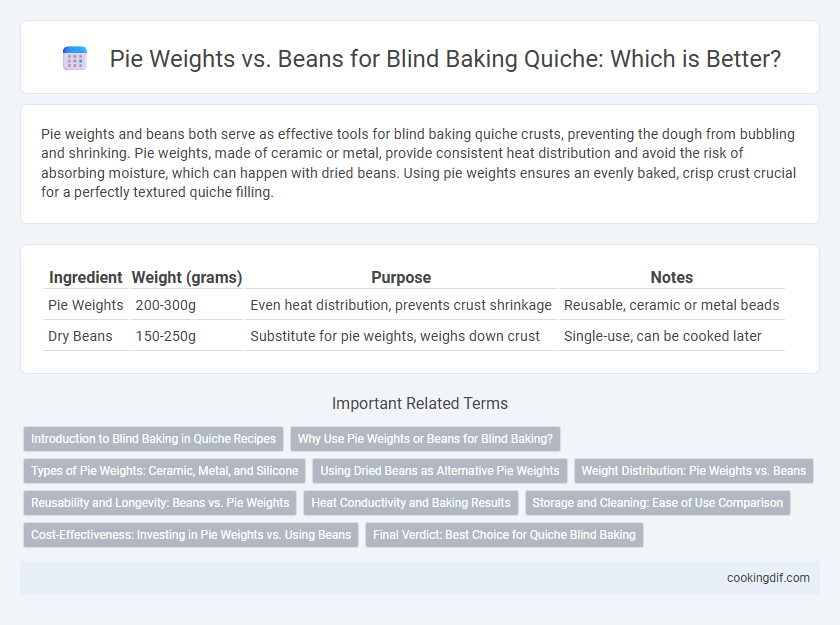Pie weights and beans both serve as effective tools for blind baking quiche crusts, preventing the dough from bubbling and shrinking. Pie weights, made of ceramic or metal, provide consistent heat distribution and avoid the risk of absorbing moisture, which can happen with dried beans. Using pie weights ensures an evenly baked, crisp crust crucial for a perfectly textured quiche filling.
Table of Comparison
| Ingredient | Weight (grams) | Purpose | Notes |
|---|---|---|---|
| Pie Weights | 200-300g | Even heat distribution, prevents crust shrinkage | Reusable, ceramic or metal beads |
| Dry Beans | 150-250g | Substitute for pie weights, weighs down crust | Single-use, can be cooked later |
Introduction to Blind Baking in Quiche Recipes
Blind baking quiche crusts requires consistent heat distribution to prevent bubbling and ensure a crisp base. Pie weights provide even pressure, minimizing shrinkage and promoting uniform baking, whereas beans can create uneven surfaces due to varying sizes. Using ceramic or metal pie weights specifically designed for blind baking enhances crust quality in delicate quiche recipes.
Why Use Pie Weights or Beans for Blind Baking?
Pie weights and beans prevent the crust from puffing up or shrinking during blind baking by evenly distributing heat and pressure. Using ceramic or metal pie weights ensures even browning and a crisp texture, while dried beans serve as an affordable alternative that effectively weigh down the dough. This step is crucial to achieve a perfectly shaped, flaky quiche crust that holds its filling without becoming soggy or misshapen.
Types of Pie Weights: Ceramic, Metal, and Silicone
Ceramic, metal, and silicone pie weights each offer unique benefits for blind baking quiche crusts, ensuring even heat distribution and preventing puffing or shrinking. Ceramic weights retain heat well, creating a crispier crust, while metal weights--often stainless steel or cast iron--provide consistent pressure and durability for multiple uses. Silicone weights offer flexibility and easy storage with non-stick surfaces, making them a popular choice for quick, efficient blind baking without affecting pie texture.
Using Dried Beans as Alternative Pie Weights
Using dried beans as alternative pie weights for blind baking quiche crusts offers an affordable and reusable solution that evenly distributes heat, preventing the dough from shrinking or puffing up. Unlike traditional ceramic or metal pie weights, dried beans conform to the crust's shape, ensuring a consistent crisp texture essential for a perfect quiche base. This eco-friendly method also eliminates the need for specialized tools, making it accessible for home bakers seeking reliable results.
Weight Distribution: Pie Weights vs. Beans
Pie weights provide consistent and even weight distribution across the pie crust, preventing air bubbles and shrinkage more effectively than beans. Beans can shift during baking, resulting in uneven pressure and potential crust deformation. Opting for pie weights ensures a uniformly baked crust, essential for delicate quiche bases.
Reusability and Longevity: Beans vs. Pie Weights
Pie weights, typically made from ceramic or stainless steel, offer superior reusability and longevity compared to dried beans, as they do not absorb moisture or char during blind baking. Beans, while a budget-friendly option, tend to degrade over time, lose their effectiveness, and are not suitable for repeated high-temperature use. Investing in quality pie weights ensures consistent crust results and reduces waste associated with single-use or deteriorating beans.
Heat Conductivity and Baking Results
Pie weights made of ceramic or metal provide consistent heat conductivity, ensuring even baking of the quiche crust during blind baking. Dried beans can create uneven heat distribution due to their irregular shapes and moisture content, potentially leading to less uniform browning or soggy spots. Using pie weights results in a crisp, well-baked crust essential for perfect quiche texture and structure.
Storage and Cleaning: Ease of Use Comparison
Pie weights offer reusable convenience with easy storage in compact containers, while beans may require dedicated airtight jars to prevent moisture absorption. Cleaning pie weights is straightforward, often involving a quick rinse and drying, whereas beans used for blind baking cannot be reused for cooking and may require disposal after use. Overall, pie weights provide a more user-friendly approach to storage and cleaning compared to beans.
Cost-Effectiveness: Investing in Pie Weights vs. Using Beans
Pie weights offer a reusable, durable solution for blind baking quiche crusts, making them cost-effective over multiple uses despite a higher initial investment. Dried beans, while inexpensive and readily available, may not distribute heat evenly and can only be used for baking, potentially increasing long-term costs due to wear and inconsistency. Choosing pie weights enhances baking precision and reduces waste, providing better value for frequent quiche enthusiasts.
Final Verdict: Best Choice for Quiche Blind Baking
Pie weights offer consistent heat distribution, preventing crust puffing and ensuring even baking crucial for a flaky quiche base. Dried beans, although a budget-friendly alternative, may cause uneven pressure and can char, potentially affecting crust quality. For precise and reliable results, pie weights remain the best choice for blind baking quiche crusts.
pie weights vs beans for blind baking Infographic

 cookingdif.com
cookingdif.com